


 |
May 24, 2017: A Day Trip to Dresden |
 |
May 22, 2017: A Guided Tour of West and East Berlin |
 |
Return to the Index for Our Visit to Berlin |
Today, Karl and Ron have booked themselves a day trip to one of the Nazi concentration camps relatively close to Berlin. Prudence, Nancy, Fred and I have decided not to do that tour, but to spend our day on Museum Island. First, Prudence has very generously arranged a tour of the National Gallery with an art historian. Then we will have lunch somewhere, and then Fred and I have planned for the four of us to visit the Pergamon Museum.
|
Getting off the train, we'll walk through Hackescher Markt Square and down to one of the bridges over onto Museum Island. We'll be meeting our tour guide right at 9:30 when the museum opens, and for the next few hours she will guide us on a tour through many of the exhibitions.
We plan to have lunch north of Museum Island in an area that is supposed to have numerous private art galleries where Prudence and Nancy would like to browse and perhaps buy a work or two.
After that, we'll walk back to Museum Island so we can visit the famous Pergamon Museum of Ancient Antiquities; they are supposed to have a huge wall that was brought intact from Egypt and which is the crown jewel of their collection.
Late in the day (or whenever we get tired, whichever comes first), we'll return to the hotel for dinner with the returned Ron and Karl. I might add here that each morning, as is her wont, Prudence likes to take a walk, and this morning Nancy and Fred went with her as she walked around the neighborhood where the hotel is located.
Our Tour of the Old National Gallery
Getting to the National Gallery
|
|
(Mouseover Image Above for Video Controls) |
Hackescher Markt ("Hacke's Market") is a square in the central Mitte locality of Berlin, situated at the eastern end of Oranienburger Strasse. It is an important transport hub and a starting point for the city's nightlife.
|
In 1882 the area received access to the Berlin Stadtbahn railway line at Berlin Hackescher Markt station, then called Börse after the nearby stock exchange. The station was renamed Marx-Engels-Platz during the GDR era, when it ended up on the wrong side of the Berlin Wall.
Formerly a rather neglected area, Hackescher Markt with its old buildings (you can see a couple of examples of the old architecture in this restaurant storefront and in this beautiful brickwork) has, since reunification, developed into a cultural and commercial center, famous for its nightlife centered on the Hackesche Höfe courtyard ensemble. The square is also served by several tramway and night bus lines. A weekly market is still held every Thursday and Saturday.
As we walked through the square towards the point where we could go under the railway and over to Museum Island, Fred got a nice picture of Nancy, Prudence, and me in the Hackescher Markt. I also took a couple of pictures of the square and stitched them together into this panorama:

As you can see on the aerial view above, we actually walked the length of the square and then under the railway line, although we could have simply exited the station on the south side. But if we'd done that, we would have missed the picturesque square. Anyway, we came out on Burgstrasse, the street running along the river heading south.
|
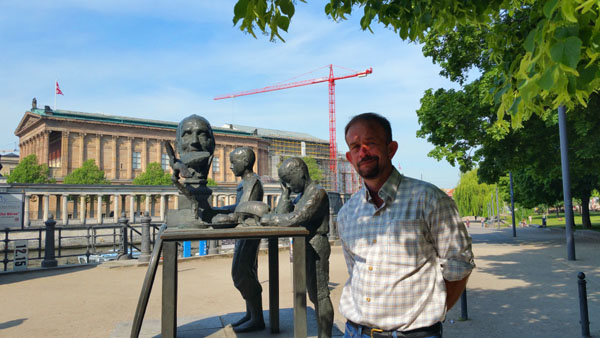
From this side of the Spree River, we could look across to Museum Island. Prudence got what I thought was an excellent picture of the museum where we were headed- the Old National Gallery- and its colonnade along the river. I adjusted it into a really neat panoramic view:
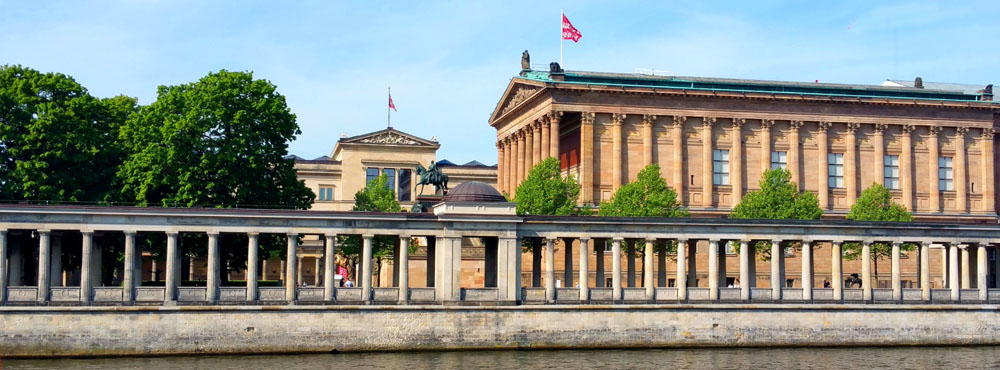
The building in the background is the Neues Museum, the museum of ancient art and archaeology, and you can see the garden area along the colonnade where the sculptures are.
|
Fred asked Nancy to stop by the railing along the river so he could get a nice picture of her and the River Spree behind her; you can see that picture here.
Then we crossed the Bodestrasse bridge onto Museum Island, and as we did so, I thought I would make a movie. You can use the player at left to have a look at it.
Our meeting with our tour guide would not be until the Museum opened at ten, and we got out front of the gallery about nine forty-five, so we had plenty of time to wander around the garden in front of it, looking at the sculptures and the fountain itself.
|
|
There were a number of life-size sculptures arrayed along the colonnade between the Old National Gallery and the River Spree.
We found five of these sculptures; one of them required two pictures because the sculptural elements were different on either side of the pedestal.
Here are our pictures of these sculptures:
 (Click on Thumbnails to View) |
The other neat feature in front of the Old National Gallery is a scallop-shaped fountain, and the best feature of it was its mosaic bottom. First, here are a couple of pictures we took by the fountain while we were waiting for the museum to open:
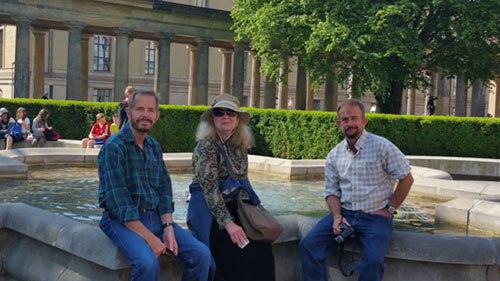 |
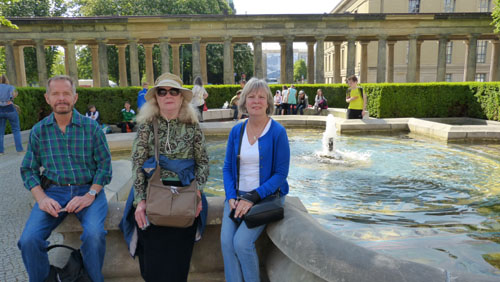 |
As I said, the fountain was very pretty because of the tiled mosaic on the bottom.
|
 (Click on Thumbnails to View) |
Now for the building itself. The first impetus to founding a German national gallery came in 1815. The idea gained momentum during the 1830s, but it wasn't until 1841 that the first real plans were created. These plans never made it to reality- at least not until the founding of the National Gallery in 1861 the National Gallery was founded, after banker Johann Heinrich Wagener donated 262 paintings by both German and foreign artists.
|
Because of the building's modern construction using brick and iron, it was widely believed to be fireproof. The exterior and outer staircase were constructed of Triassic sandstone.
The Old National Gallery building was constructed in an architectural style that is a mix between late Classicism and early Neo-Renaissance. It was intended to express "the unity of art, nation, and history", and therefore has aspects reminiscent of a church (an apse) and a theatre (the grand staircase) as well as a temple. An equestrian statue of Frederick William IV tops the stairs, and the inside stairs have a frieze by Otto Geyer depicting German history from prehistoric times to the 19th century.
The exterior of the building still retains its original appearance, whereas the interior has been renovated many times in order to suit the exhibits. The Old National Gallery is connected via walkways to the Pergamon Museum to the north, and to the Neues Museum, the Altes Museum, and the Berlin Cathedral to the south.
|
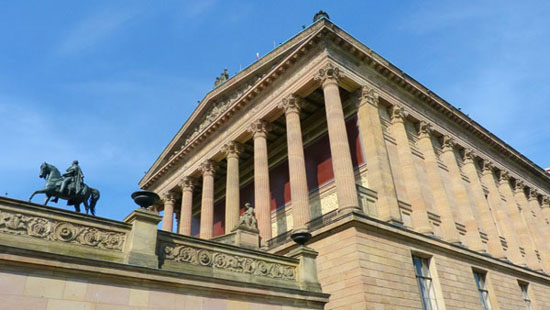
Meeting Our Guide
|
|
The museum's collection was basically the Wagener's donation for many years. When Max Jordan became the first director of the National Gallery in 1874, he began implementing the Kaiser's desire that the Museum be devoted to German art. In 1896, however, his successor began acquiring Impressionist works, risking conflict with the Kaiser because this changed the focus of the collection. Indeed, Laureline told us, by the turn of the century the German National Gallery was the most important museum for modern French Art- even including museums in France itself.
We spent almost four hours with Laureline as she took us through almost the entire museum. Her specialty was German Art, but she was knowledgeable about the other genres as well, and we thoroughly enjoyed her insights. Of course we took a great many pictures (photography being unrestricted except for flash pictures in most gallery rooms), and the question becomes how I can organize them here. I'll just take them basically in sequence, beginning with our time in the gallery devoted to one of Laureline's favorite artists- Caspar David Friedrich.
The Art of Caspar David Friedrich
|
 (Click on Thumbnails to View) |
Friedrich is best known for his mid-period allegorical landscapes which typically feature contemplative figures silhouetted against night skies, morning mists, barren trees or Gothic or megalithic ruins. His primary interest as an artist was the contemplation of nature, and his often symbolic and anti-classical work seeks to convey a subjective, emotional response to the natural world. Friedrich's paintings characteristically set a human presence in diminished perspective amid expansive landscapes.
Friedrich was born at the Baltic Sea, where he began his studies in art as a young man. He studied in Copenhagen until 1798, before settling in Dresden. He came of age during a period when, across Europe, a growing disillusionment with materialistic society was giving rise to a new appreciation of spirituality. This shift in ideals was often expressed through a reevaluation of the natural world, as artists such as Friedrich, Turner, and Constable sought to depict nature as a divine creation, while human civilization was only an artifice.
|
Friedrich's work brought him renown early in his career, and contemporaries such as the French sculptor David d'Angers (1788–1856) spoke of him as a man who had discovered "the tragedy of landscape". Nevertheless, his work fell from favour during his later years, and he died in obscurity, and in the words of the art historian Philip B. Miller, "half mad".
As Germany moved towards modernization in the late 19th century, a new sense of urgency characterised its art, and Friedrich's contemplative depictions of stillness came to be seen as the products of a bygone age. The early 20th century brought a renewed appreciation of his work, beginning in 1906 with an exhibition of thirty-two of his paintings and sculptures in Berlin.
By the 1920s his paintings had been discovered by the expressionists, and in the 1930s and early 1940s surrealists and existentialists frequently drew ideas from his work. The rise of Nazism in the early 1930s again saw a resurgence in Friedrich's popularity, but this was followed by a sharp decline as his paintings were, by association with the Nazi movement, interpreted as having a nationalistic aspect.
It was not until the late 1970s that Friedrich regained his reputation as an icon of the German Romantic movement and a painter of international importance.
So the question becomes how best to include the many pictures we took of Friedrich's work during the first part of our museum tour? I suppose that the best way is to use a slide show, so if you want to see all his pictures you won't have to continually open and close popup windows.
|
|
Friedrich's reputation steadily declined over the final fifteen years of his life. As the ideals of early Romanticism passed from fashion, he came to be viewed as an eccentric and melancholy character, out of touch with the times. Gradually his patrons fell away, and by 1820 he was living as a recluse and was described by friends as the "most solitary of the solitary". Towards the end of his life he lived in relative poverty and was increasingly dependent on the charity of friends. He became isolated and spent long periods of the day and night walking alone through woods and fields, often beginning his strolls before sunrise.
By the time of his death in 1840 in Dresden (where he is buried) his reputation and fame were waning, and his passing was little noticed within the artistic community. His artwork had certainly been acknowledged during his lifetime, but not widely. While the close study of landscape and an emphasis on the spiritual elements of nature were commonplace in contemporary art, his work was too original and personal to be well understood. By 1838, his work no longer sold or received attention from critics; the Romantic movement had been moving away from the early idealism that the artist had helped found.
One thing I noted while were in the Friedrich exhibit was that we weren't the only folks learning about the art from a professional- apparently, this museum (and I presume others) are an educational opportunity for German schoolkids. I doubt that many American schoolchildren ever take a field trip to a museum at all. You can see that this is a frequent occurrence here, as each kid came with his own seatpad for sitting on the floor.
Sculpture
 (Click on Thumbnails to View) |
The Art of Adolph Menzel
|
|
Menzel's popularity in his native country was such that few of his major paintings left Germany, as many were quickly acquired by museums in Berlin. Menzel's graphic works and drawings were more widely disseminated; these, along with informal paintings not initially intended for display, have largely accounted for his posthumous reputation. Although he traveled in order to find subjects for his art, to visit exhibitions, and to meet with other artists, Menzel spent most of his life in Berlin, and was, despite numerous friendships, withdrawn (perhaps owing to the fact that he had a large head and was barely four-foot-six).
Nevertheless, his renown entailed social obligations, and in the 1880s the poet Jules Laforgue described him as "no taller than a cuirassier-guard's boot, bedecked with pendants and orders, not missing a single one of these parties, moving among all these personages like a gnome and like the greatest enfant terrible for the chronicler." In Germany he received many honors, and in 1898 became the first painter to be admitted to the Order of the Black Eagle; by virtue of which he became a noble- styled "Adolph von Menzel". He was also made a member of the Académie des Beaux-Arts in Paris and the Royal Academy in London. After his death in 1905 in Berlin, his funeral arrangements were directed by the Kaiser, who walked behind his coffin.
Interior Views: The Old National Gallery
|
|
|
The pictures at left are pretty much in sequence. In the leftmost, Fred and Prudence are going up the first short flight to the bottom of the stairs in the second picture. At the top of the first flight of stairs in that picture (where the stairs turn to the right) there was a simian sculpture sitting on the stairpost, and that is where Fred took the third picture.
The two pictures below were taken on that same staircase; this time as we were going down it later in the day.
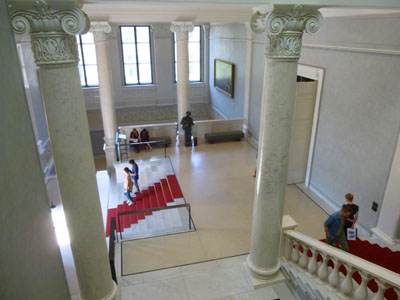 This picture was taken from just above the simian sculpture and looks back down to the second floor lobby. |
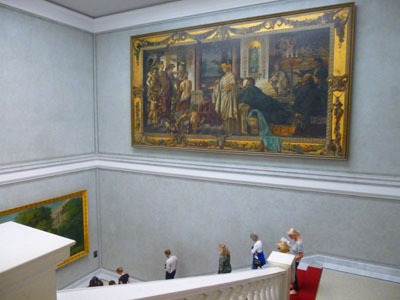 This picture was taken from the top of the stairs on the second floor, just before we went to the Friedrich galleries. |
The stairs up to the third floor were similar, but there was the additional feature of a sculpted border relief that ran around the open stairwell; this border showed over a hundred figures from German history- most of them named just below the sculpted relief strip. I thought I might try to photograph the whole thing, but there was no one place I could stand to do that. Here are some samples, though:
|
|
|
We all thought that the museum itself was very nicely decorated inside; the halls were wide and the galleries had plenty of space from which to view the artworks. The whole building was classic in design. Here are some of the best interior pictures that we took:
 (Click on Thumbnails to View) |
The Paintings of Max Liebermann
He used his inherited wealth to assemble an impressive collection of French Impressionist works, and later chose scenes of the bourgeoisie, as well as aspects of his garden near Lake Wannsee, as motifs for his own paintings. In Berlin, he became a famous painter of portraits; his work is especially close in spirit to Édouard Manet. He completed more than 200 commissioned portraits over the years, including of Albert Einstein and Paul von Hindenburg.
Here are some of the Liebermann paintings that Laureline talked to us about and which we photographed. To look at any of them, just click on its thumbnail.
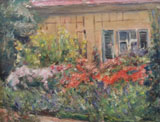 Flower Perennials on Gardener's House (1928) |
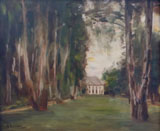 The Birch Path in the Wannsee Garden (1926) |
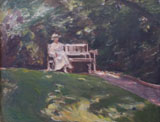 The Garden Bench (1916) |
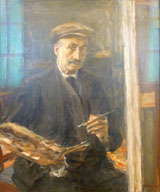 Self-Portrait with Sports Cap at the Easel (1925) |
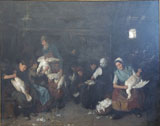 Women Plucking Geese (1872) |
 Flax Barn at Laren (1887) |
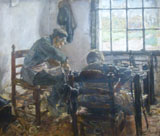 Cobbler's Workshop (1881) |
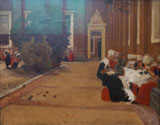 Amsterdam Orphan Girls (study) (1876) |
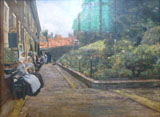 Stevenstift in Leiden (1889) |
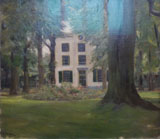 Country House in Hilversum (1901) |
In 1909 Liebermann bought property in Wannsee, a wealthy suburb of summer homes on the outskirts of Berlin, and designed a villa with gardens there. From the 1910s until his death, images of the gardens dominated his work. On his 80th birthday, in 1927, Liebermann was celebrated with a large exhibition, declared an honorary citizen of Berlin and hailed in a cover story in Berlin's leading illustrated magazine. Liebermann died on February 8, 1935, at his home on Berlin's Pariser Platz, near the Brandenburg Gate. Although Liebermann had been famous, his death was not reported in the media, now controlled by the Nazis, and there were no representatives of the Academy of the Arts or the city at his funeral in the Jewish Cemetery on Schönhauser Allee. However, despite official strictures by the Gestapo, more than 100 friends and relatives attended the funeral.
Other Paintings and Artwork
|
|
As it turned out, we got an extensive look at the National Gallery's collection. As we learned, it contains works of the Neoclassical and Romantic movements (by artists such as Caspar David Friedrich, Karl Friedrich Schinkel, and Karl Blechen), of the Biedermeier, French Impressionism (such as Édouard Manet and Claude Monet) and early Modernism (including Adolph von Menzel, Max Liebermann and Lovis Corinth).
The Alte Nationalgalerie houses one of the largest collections of 19th-century sculptures and paintings in Germany, and we were fortunate to have an excellent guide who gave us a wide survey. With her knowledge and insights, we learned a lot more about the paintings and sculptures than we would have just by looking at them.
Lunch in the Gallery District
|
At left is an aerial view of the area of Berlin that we traversed over lunchtime, and on it I have marked our approximate route.
As you can see, we recrossed the bridge onto Museum Island and then walked along the River Spree and through James Simon Park. There was a tunnel under the S-Bahn line and we continued to walk along the river along the south side of Monbijoupark. This brought us to Monbijoustrasse where we turned north to Oranienburgerstrasse, where we turned left to continue northwest.
We passed by the New Synagogue of Berlin and then came to the corner of Tucholskystrasse. There was a restaurant called the Grand Bar on that corner, and that's where we stopped to have lunch.
After lunch, we headed a couple of blocks north to see if we could find a gallery or two (but weren't very successful). We found our way back to the northern tip of Museum Island, and I planned for all of us to visit the Pergamon Museum for the afternoon.
As we walked along the river around to the northwest, I had a good opportunity to create a panoramic view beginning looking south along the river and then panning across the Alte Nationalgalerie and the Bode Museum to look northwest:

All of the pictures we took during our lunchtime walk were very, very candid shots. The neighborhoods we walked through were interesting, but nondescript, so both Fred and I took pictures only when there was something quirky to record.
|
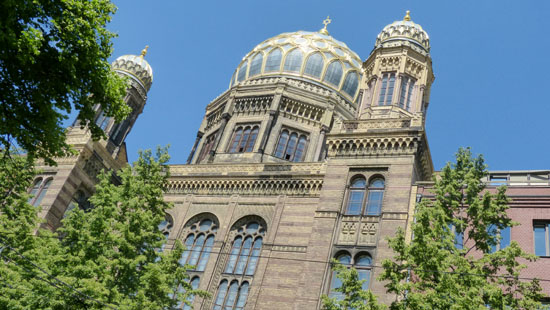 |
The front of the building, facing Oranienburger Strasse, is richly ornamented with shaped bricks and terracotta, accented by colored glazed bricks. Beyond the entrance, the building's alignment changes to mesh with pre-existing structures. The synagogue's main dome with its gilded ribs is an eye-catching sight. The central dome is flanked by two smaller pavilion-like domes on the two side-wings. Beyond the façade was the front hall and the main hall with 3,000 seats. Due to the unfavourable alignment of the property, the building's design required adjustment along a slightly turned axis.
The Neue Synagoge is also a monument of early iron construction. The new building material (iron was previously not used in building construction) was visible in its use for the outside columns, as well as in the dome's construction. (Iron was also a core component for the now-lost floor structure of the main hall.)
We found a restaurant on the corner- the Grand Bar- and it looked as if they had an extensive lunch menu so we decided to make it our lunch stop. Fred and I shared a kind of chicken sandwich chicken sandwich, while Nancy and Prudence shared a small pizza. Fred and I each took one good picture here at the Grand Bar:
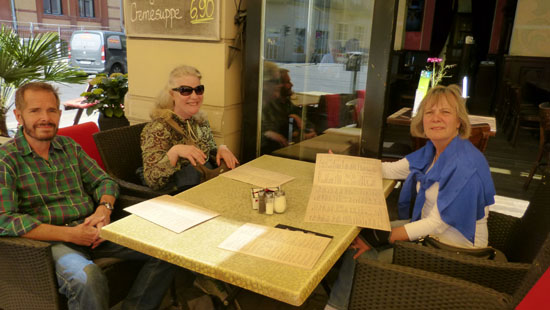 |
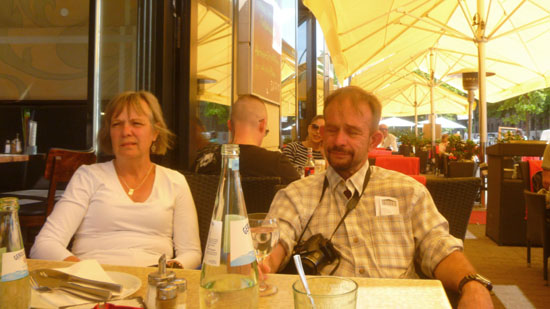 |
Now if you want something quirky, let me tell you about what happened when I got up after lunch to go use the "facilities" at the Grand Bar.
|
Of course I don't speak German (or read it either, for that matter), so I can only assume that the English translation is accurate- if only in spirit as opposed to being correct in grammar. But I won't fault them; other countries do more than they should to accommodate English-speaking tourists. (Think New York City restaurants would put up such a sign in German or French?) Anyway I found the sign's translation humorous, although understandable.
There was also a little sign directing patrons to the temporary restrooms which I was eventually able to find. When I did, I found a familiar scene.
When we got done with lunch, we thought we'd head off north along Tucholskystrasse to see if we could find a gallery or two for Prudence and Nancy to look through.
|
Since 1713 there had been a residential house for postillons on this property; these were private drivers who carried out the transport of persons and mails on behalf of the Post Office. After 1766 there was the post office with the rooms of the royal postmaster, a general contractor, who took over and carried out all the tasks of the post office. In the second half of the 19th century this traditional structure was no longer able to cope with the postal traffic in Berlin. In 1874 the post office of the Reichspost was integrated and transferred to a newly founded Postfuhramt.
The old stables and wooden houses were torn down and and this entirely new building was built in its place. It was like a main post office (although there were other main stations in Berlin). The building was severely damaged in the bombing during World War II, but was repaired after the war and then reconstructed in the 1980s. Its function as a post office continued until the mid-1990s; it is now a government office building. Fred was impressed with the detail decoration of the building facade.
Figures of children representing different attributes of the postal system decorate the building. The original allegorical figures on the roof above the main portal were badly damaged during the war, dismantled in 1953, and the replaced in the reconstruction.
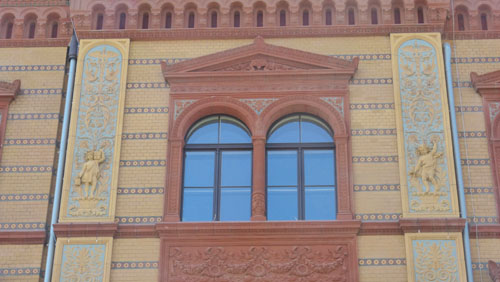 |
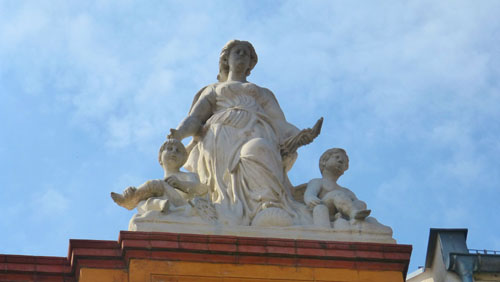 |
We did end up wandering around the neighborhood for a while, looking for art galleries, but we found precious few of them- certainly not offering the kinds of classical pastels and oils that interest Prudence and Nancy. It was a nice walk around the area, though, but we didn't want to spend so much time here that we wouldn't have time to visit the Pergamon Museum.
|
|
When we went into this little gallery space, I thought that the artist was just a local Andy Warhol wannabe. I was surprised, though, when I did some research for this page. As it turns out, Polke achieved early success for his paintings and drawings of consumer goods (like Warhol). His mid-1960s works remain the artist’s most recognizable and have performed the best at auction. A first record price for Polke’s work at auction was established at Christie's in London in 2007 when a buyer paid $5.3 million for a 1966 canvas titled Strand (Beach). At a Sotheby's auction in London in 2011, Polke's City Painting II (1968) sold for $7.4 million, and his Jungle (1967) established a new record for the artist at $9.2 million. Meanwhile, his photographs were no slouches either, with Untitled (São Paolo Series)- a 1975 series of 10 photographs Polke made for the São Paulo Biennial, sold for just shy of $1 million. Remember "Jungle" that set a record for the artist in 1967? It sold again two years ago in 2015, this time for $27.1 million!
We weren't very successful in finding a gallery, so we headed back to Museum Island to visit the Pergamon Museum.
A Visit to the Pergamon Museum
Getting to the Pergamon Museum
|
So we had to walk down the west side of the canal until we came to the same street we'd been on before- the Bodestrasse- that runs all the way across the island. There is actually another bridge that you can usually take midway down to get to the Pergamon, but it was closed for the construction of the new wing.
So we went down to Bodestrasse, got over onto the island, and then walked between the Alte Nationalgalerie and the Neues Museum and came to the colonnade at the entrance to the Pergamon.
Before we head into the Pergamon, there are two pictures I took on the way down the west side of the island.
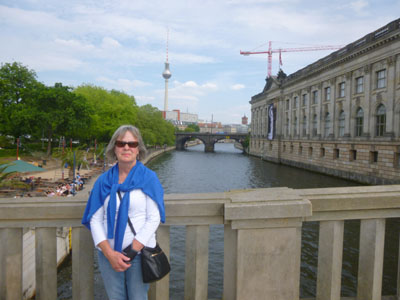 Here is Prudence on the bridge across the Spree; the view looks south-southeast towards Alexanderplatz. |
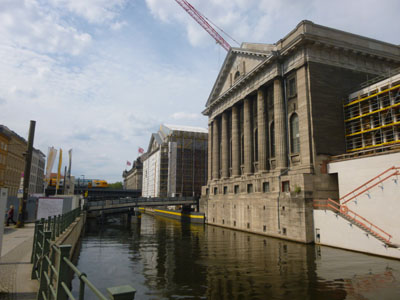 This picture was taken from Bodestrasse and looks back up the canal on the west side of Museum Island. |
There was no line at the Pergamon, which I found unusual, as I understood from the Internet and from Greg who'd been there last year that the Pergamon Altar was an incredibly popular attraction. Sadly, we would find out why this was the case, but that wouldn't happen for a while yet. We went in with no delay, got tickets, and started into the galleries.
The Ishtar Gate
|
The bricks in the gate were covered in a blue glaze meant to represent lapis lazuli, a deep-blue semi-precious stone that was revered in antiquity due to its vibrancy. These blue glazed bricks would have given the façade a jewel-like shine. Through the gate ran the Processional Way, which was lined with walls showing about 120 bulls, dragons, lions and flowers on enameled yellow and blue glazed bricks, symbolizing the goddess Ishtar. The gate itself depicted only gods and goddesses. These included Ishtar, Adad and Marduk. During celebrations of the New Year, statues of the deities were paraded through the gate and down the Processional Way.
The gate, being part of the Walls of Babylon, was considered one of the original Seven Wonders of the World. It was replaced on that list by the Lighthouse of Alexandria from the third century BCE.
|
One of most complex and impressive architectural reconstructions in the history of archaeology was the rebuilding of Babylon's Ishtar gate and Processional Way here in Berlin. Hundreds of crates of glazed brick fragments were carefully desalinated and then pieced together. Fragments were combined with new bricks baked in a specially designed kiln to re-create the correct color and finish. It was a double gate; the part that is shown in the Pergamon Museum today is the smaller, frontal part. The larger, back part was considered too large to fit into the constraints of the structure of the museum; it is in storage.
The reconstruction of the Ishtar Gate and Processional Way was built here includes the inscription plaque. The Gate stands 46 ft high and 100 ft wide. The excavation ran from 1902 to 1914, and, during that time, 45 ft of the foundation of the gate was uncovered.
|
(Mouseover Image Above for Video Controls) |
In another gallery, we happened to find a model of the Ishtar Gate and Processional Way and it gave us a better idea of how the separate elements of the site that had been reconstructed here had fit together originally.
|
 (Click on Thumbnails to View) |
Parts of the gate and lions from the Processional Way are in various other museums around the world, although four museums acquired dragons. The Istanbul Archaeology Museum has lions, dragons, and bulls and the Ny Carlsberg Glyptotek in Copenhagen, Denmark, has one lion, one dragon and one bull. Other museums with one or more of the animal types include the Detroit Institute of Arts, Sweden's Röhsska Museum, the Louvre, the State Museum of Egyptian Art in Munich, the Kunsthistorisches Museum in Vienna, the Royal Ontario Museum in Toronto, the Metropolitan Museum of Art in New York, the Oriental Institute in Chicago, the Rhode Island School of Design Museum, the Museum of Fine Arts in Boston, and the Yale University Art Gallery in New Haven, Connecticut. If you are close to any of these museums, you should go have a look.
The Ishtar Gate was amazing, but it was just one of three major reconstructions on display at the Pergamon.
The Market Gate of Miletus
|
If you are curious, here are the three separate pictures that were first adjusted for perspective and then put together into a single image:
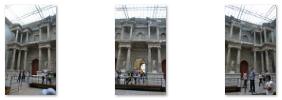 (Click on Thumbnails to View) |
The gate is a large marble monument, about 95 feet wide, 50 feet tall, and 15 feet deep. The two-story structure has three doorways and a number of projections and niches. At roof level and in between the floors are ornate friezes with bull and flower reliefs. The structure's protruding pediments are supported by Corinthian and composite columns. The gate is not entirely original, as little of the base and lower floor survived the centuries; additional material includes brick, cement, and steel. The gate is affixed by iron girders to the wall behind it. While in Miletus, niches on the second story featured statues of emperors, some fighting against barbarians. One other interesting note were the coffered ceilings on the underside of the upper floors.
|
German archaeologist Theodor Wiegand conducted a series of excavations in Miletus from 1899 through 1911. In 1903, the Market Gate of Miletus was excavated and from 1907 to 1908, fragments of the gate were transported to Berlin. Wiegand wrote in his diaries that he gave a presentation using models to Kaiser Wilhelm II, who was so impressed that he ordered the gate's reconstruction at full scale "like a theater backdrop" in the Pergamon Museum.
From 1925 to 1929, 750 tons of fragments were used to reassembble the gate in the recently expanded museum. It was like a puzzle with a great many pieces missing, so "new" pieces had to be fabricated to fill in the gaps. For the lower structure, brick and cement reinforced with steel supplemented the few remains. More of the upper structure had survived, but still supplemental material had to be used. To support the structure, original column fragments were bored out, and then steel supports put inside them. The museum did an excellent job, but still was criticized for portraying the monuments as original when so much supplemental material was used.
The gate suffered significant damage from aerial bombardment in World War II when the roof and skylight above the gate were destroyed along with a protective brick wall. The right wing collapsed and the structure was damaged by fire and shrapnel; the loss of the brick wall also exposed the gate to weathering for two years. A temporary roof was constructed to protect the gate from the elements, and from 1952 to 1954 the structure was extensively restored under the supervision of archaeologist H. H. Völker (although little documentation exists describing the specific work that took place.
|
The Antiquity Collection: Greek, Roman, European
|
|
As usual, you can move through the slides with the lower-corner arrows, and you can track your progress with the index numbers in the upper left corner. (The last few slides in the show are the items whose descriptive plaques we missed taking pictures of.)
When we were finished in the Greco-Roman antiquities, I thought that we should go ahead and see the Pergamon Altar- the focal point of the Pergamon Museum.
The Pergamon Altar
|
The structure is 120 feet wide and 100 feet deep; the front stairway alone is almost 65 feet wide. The base and inner court walls are decorated with numerous friezes. Excavation of the altar took eight years (1878-1886) and negotiations with the Turkish government resulted in the friezes and this structure being brought to Berlin and placed in this museum which was erected for the purpose. (That museum was demolished in 1909 and this one opened in 1930.) The Pergamon Altar is today the most famous item in the Berlin Collection of Classical Antiquities. The altar exhibit closed on September 29th, 2014 for a complete remodeling of the exhibit hall (including a new glass ceiling and climate-control system); the exhibit is scheduled to reopen in late 2019 or early 2020.
Disappointed in not being able to see the altar, we nevertheless used the time to visit another section of the Antiquities exhibit.
The Antiquities Collection: Turkish, Assyrian, Sumerian and Babylonian Artifacts
|
The stairs up from the entry level are through the archway on the left, and the stairs up to the museum galleries holding Islamic Art are just beyond them. (As I mentioned earlier, the Pergamon Museum holds only a fraction of the objects the German museums have; the majority are spread out over other separate museums, some on Museum Island and some not.
The closed gallery containing the Pergamon Altar is on the left side of the hall, and the galleries we will visit next are on the right side and at the far end of the hall. So we will head now through the archway and then right into the first of these galleries, and then will work our way to the large gallery at the far end before returning to the main hall.
When we finish and return to the main hall, you will get an excellent view of most of the Processional Way, as it turns out, but I'll save that view for when we get there. (If we have time, I also want to go upstairs just to see what the Islamic Art galleries look like, although I doubt there will be time to go through them.
|
|
As usual, move from slide to slide with the little arrows in the lower corners, and track your progress with the index numbers in the upper left. Where there was interesting information on a description plaque and we photographed it, I have transcribed that information to the appropriate slide. We hope you enjoy the show!
Islamic Art/The End of Our Visit to the Pergamon
|
|
I also had time to take two final pictures of the animals shown in relief all along the Processional Way, and these are below:
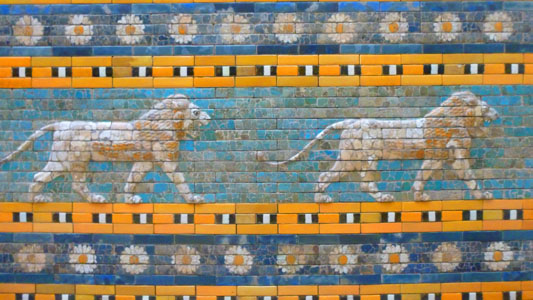 |
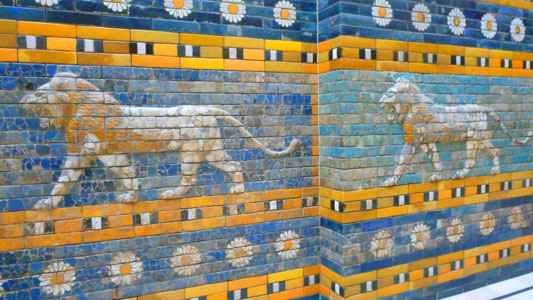 |
I wanted to head upstairs for just a few minutes to see what the Museum of Islamic Art (sited here in the Pergamon) looked like. I knew that I wouldn't be able to see much, but I thought I might at least get to see the Aleppo Room, one of the famous exhibits in this part of the museum. I did get to see the Aleppo Room, which is behind glass to keep people from touching the walls. Below is my one photograph of the room, and beside it a scrollable window containing the information from a large descriptive plaque that was off to the side.
|
It looked like the display galleries here were pretty typical, but the items on display looked interesting, so maybe on a return trip...
I returned downstairs, collected everyone, and we left the museum and head back off Museum Island to the Hackescher Markt station, and from there we made our way back to the hotel. Ron and Karl had returned, so we had drinks on the patio and then had dinner right there in the hotel.
You can use the links below to continue to another photo album page.
 |
May 24, 2017: A Day Trip to Dresden |
 |
May 22, 2017: A Guided Tour of West and East Berlin |
 |
Return to the Index for Our Visit to Berlin |